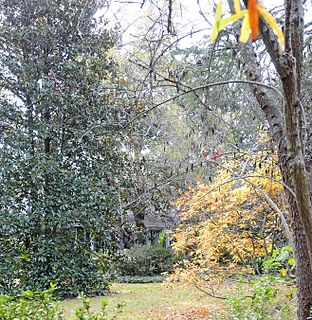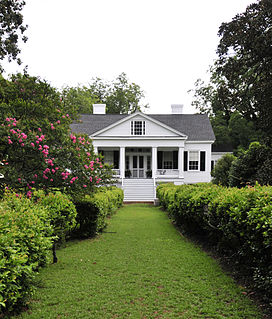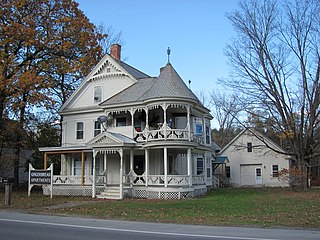
Redcliffe Plantation State Historic Site is a state park in South Carolina, United States. Redcliffe Plantation, also known as Redcliffe, completed in 1859, is a Greek Revival plantation house located on the site that is listed on the National Register of Historic Places. The house was designed by the baron Louis Berckmans and was built in 1857. It was built for James Henry Hammond and was home to three generations of his descendants. His great-grandson John Shaw Billings, editor of Time, Life, and Fortune magazines, donated the estate and collections to the people of South Carolina in 1973. The same year it was added to the National Register of Historic Places.

Magnolia House, also known as the Johnson-Kinney House, located in Bennettsville, South Carolina, is a fine example of an excellently preserved late antebellum neoclassical, or "bracketed Greek Revival" home in rural South Carolina. Magnolia is a two-story frame house constructed in 1853 by Bennettsville lawyer, William Dalrymple Johnson. Johnson was a signer of the South Carolina Ordinance of Secession.
Carter Hill is a historic plantation complex located near Camden, Kershaw County, South Carolina. The overseer's house was built about 1840, and now incorporated into the main house built about 1875. The overseer's house was a one-room house, that incorporates architectural elements in the Greek Revival style. The main house reflects the rural Victorian architectural style predominant after the American Civil War. Also on the property are a log building, a frame building, a pump house, a smokehouse, a dovecote, a hen house, and a barn constructed at various times during the 19th century. It was listed on the National Register of Historic Places in 1992.

Chester Congregational Church is a historic church at 4 Chester Street in Chester, New Hampshire. This wood-frame building was originally built as a traditional New England colonial meeting house in 1773, and underwent significant alteration in 1840, giving it its present Greek Revival appearance. It was listed on the National Register of Historic Places in 1986.

The Howe-Quimby House is a historic house on Sugar Hill Road in Hopkinton, New Hampshire. Built about 1780, it is a well-preserved example of a rural 18th-century farmhouse with later stylistic modifications. The house was listed on the National Register of Historic Places in 1980.

Nuckolls-Jefferies House, also known as the Nuckolls House and Wagstop Plantation, is a historic plantation house located near Pacolet, Cherokee County, South Carolina. It was built in 1843, with alterations in the 1870s or 1880s. It is a 2+1⁄2-story, frame residence in a combined Greek Revival / Classical Revival style. It is clad in weatherboard and sits on a stone foundation. The front facade features a two-tiered central, pedimented portico supported by two sets of slender wooden posts. The rear of the house has a two-story ell, built during the 1996 restoration. Also on the property are three contributing outbuildings: a small, one-story log gable-front building that dates from the mid-to-late 19th century that served as the farm's smokehouse, a 1+1⁄2-story gable-front frame barn, and another frame gable-front barn with side shed lean-to extensions.

Colvin–Fant–Durham Farm Complex, also known as the Nicholas Colvin House and Durham House, is a historic home and farm complex and national historic district located near Chester, Chester County, South Carolina. The district encompasses six contributing buildings. The house was built about 1835, and is a vernacular farmhouse with transitional Federal and early Greek Revival detailing. The house consists of a two-story, hall and parlor plan, frame main block and a one-story, frame dining room and kitchen ell, which was added in the late-19th century. The property also includes a smokehouse, well house/power house, mule barn, tenant house, and a log cottonseed house.

Landsford Plantation House, also known as the Davie House, is a historic plantation house located near Richburg, Chester County, South Carolina. It was built about 1828, and is a 2+1⁄2-story, timber-framed weatherboarded vernacular residence. The house has a square plan and is two rooms deep. The main façade featured a one-story porch, resting on brick piers, and added about the turn of the 20th century. Landsford Plantation achieved local prominence as the social center of a 3,000 acres (1,200 ha) Piedmont cotton plantation in the mid-19th century. Of the original outbuildings, only a barn of log construction remains.

Davis Plantation is a historic plantation house located near Monticello, Fairfield County, South Carolina. It was built about 1845, and is a two-story, white frame Greek Revival style house. It has a hipped roof and two mammoth chimneys. It features a gabled front portico supported by four square, paneled Doric order columns. The house was built by James B. Davis, descendant of Revolutionary War Captain, James Kincaid, and an early pioneer in South Carolina agricultural development.

Rural Point, also known as Robertson House and Doty House, is a historic home and garden located at Winnsboro, Fairfield County, South Carolina. It was built in 1852, and is a 1+1⁄2-story, 12 bay, Greek Revival style frame dwelling over a high basement. The façade features a gable-roofed porch which is supported by four square columns. The property features a semi-formal garden said to have been designed by John Grimke Drayton, noted landscape architect of Magnolia Gardens in Charleston, South Carolina. Also on the property is a typical southern planter's office of white clapboard. It was built by William Ross Robertson, probate judge and commissioner of equity of Fairfield County who served in South Carolina House of Representatives and as a member of the Secession Convention.

Rankin-Harwell House, also known as The Columns, Carolina Hall, and the James Harwell House, is a historic plantation house located near Florence, Florence County, South Carolina. It was built in 1857, and is a two-story, frame, Greek Revival style dwelling. It features 22 giant freestanding Doric order stuccoed brick columns that surround the house on three sides. It rests on a raised basement and has a low-pitched hipped roof.

James Carnes House, also known as "The Myrtles," is a historic home located at Bishopville, Lee County, South Carolina. It was built about 1836, and is a two-story, Greek Revival style frame house. It has a gable roof, weatherboard siding, brick foundation and stuccoed exterior end brick chimneys. The house features a large, two-story, pedimented portico on the front façade, with four larger square, frame columns with Doric order motif capitals. A large 1+1⁄2-story addition was added to the rear about 1900, when the house was made into a boarding house.

The Durham House is a historic house on Ball Park Road in Goshen, New Hampshire. Built about 1860, it is one of a cluster of plank-frame houses built in the rural community in the 19th century. This one is further note for its Greek Revival features, and its construction is tentatively ascribed to James Chandler, a noted local builder. The house was listed on the National Register of Historic Places in 1985.

The Garber House is a historic house on Lempster Coach Road in Goshen, New Hampshire. Built about 1835, it is one of a cluster of plank-frame houses in the rural community, which at one time had an unusually fine Greek Revival entry surround. The house was listed on the National Register of Historic Places on June 21, 1985.

Calhoun-Gibert House is a historic home located at Willington in McCormick County, South Carolina. It was built about 1856 and was originally a one-story Greek Revival style dwelling.
Keziah Goodwyn Hopkins Brevard House, also known as Alwehav, is a historic plantation house located in rural Richland County, South Carolina, near Eastover. The original house was built about 1820, and enlarged to its present size about 1850. It is a large, two-story, vernacular Greek Revival style residence with Italianate features. Also on the property are the remnants of a water tower, a frame stable, a barn, three frame sheds, a well, and four modern shed buildings. The property also has a number of unique horticultural specimens.
Laurelwood is a historic plantation house located in rural Richland County, South Carolina, near the city of Eastover. It was built about 1830, and is a two-story frame dwelling with a central-hall, double-pile plan. The front façade features a two-tier, three bay, pedimented portico in the Greek Revival style. It has a one-story, frame addition built in the early-20th century. Also on the property ate the contributing frame smokehouse and a frame barn. Also notable is the survival of a slave quarters.

The Bivings-Converse House is a historic house located at 1 Douglas Street near Glendale, Spartanburg County, South Carolina.

The Greenwood House, now the Gingerbread Apartments, is a historic house on Vermont Route 103 in Chester, Vermont. Built about 1850 and restyled about 1900, it is an architecturally distinctive blend of Greek Revival and Late Victorian styles. It was listed on the National Register of Historic Places in 1985.

The Wilcox-Cutts House is a historic house on Vermont Route 22A in Orwell, Vermont, USA. Its oldest portions date to 1789, but it is regarded as one of Vermont's finest examples of late Greek Revival architecture, the result of a major transformation in 1843. The house and accompanying farmland, also significant in the development of Morgan horse breeding in the state, was listed on the National Register of Historic Places in 1974.





















